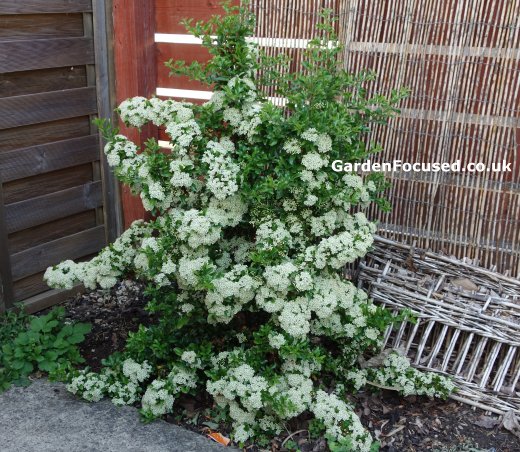PYRACANTHA (FIRETHORN)
Article by DavidMarks
Pyracantha originate from Southern Europe (Mediterranean areas inparticular) spreading eastwards into Asia. They are equally at home in highdaytime temperatures and low night time ones. Their flowers and berries makethem stand out as exceptional ornamental plants in small and large gardens.Their dense growth, combined with vicious thorns also make them idealhedging plants. Even the most determined intruder would not wish to cross afully grown Pyracantha!
This article should answer all your questions about choosing and caring forpyracantha. Occasionally however our readers have very specific questions aboutthis shrub. So if up can’t find the answer to your question on this page thencheck out our “question and answer” page dedicated to pyracantha. It can be found
here.
They have been popular plants in gardens for centuries and remain so for very good reasons.

Three year old pyracantha in May
Use the checklist below to decide if a Pyracantha is suited to yourpreferences and garden conditions:
- An evergreen shrub which, if not pruned, reaches a height of 4m / 13ft witha similar spread. They respond exceptionally well to pruning and can easily be kept to a height andspread of 1m / 3ft.
- It is fully hardy in almost all areas of the UK withstandingtemperatures down to -18°C. In a protected position, it is hardy to afew degrees lower.
- Main interest is from the masses of white flowers in May / Junefollowed by red, orange or yellow berries in September to February.
- All soils except waterlogged conditions are suitable.It does best in a deep loam type soil although this is not essential.
- It prefers full sun although also does well in partial shade. Avoidfull shade positions.
- Once established, it rarely requires watering and will toleratedrought. If grown against a wall, watering will be required during extendeddrought periods.
- A very versatile shrub, it can be grown as a specimen plant, singlyin containers, as a hedge or against a wall / fence. It is very suitable as a barrier hedge becauseit has lots of very sharp thorns and cannot easily be parted.
- Disease resistance is good with the exception of scab and fireblight. See oursection below on pests and diseases of this shrub for top tips aboutavoiding this problem. The more recent ‘Saphyr’ series of Pyracantha showsignificant resistance to both these diseases.
- These are very low maintenance shrubs. When established their onlycare need is pruning to keep them to size and shape you require.
- Birds love to nest in pyracantha because not only are they protectedfrom predators by the thorns but they also feed on the berries. Theflowers are also attractive to bees.
HOW TO PLANT A NEW PYRACANTHA
Follow the steps below to ensure your Pyracantha is planted correctly and in the best position:
- Choose a full sun to partial shade position. The plant needs some aircirculation so although it will thrive against a wall or fence, avoidplanting it in the corner of two walls fences.
- If the soil is heavy or is not free draining addlots of well rotted compost to the area and dig it in well.
- It can be planted all year long if the soil is not frozen and youcan water well when conditions are dry. Mid March to April and midSeptember to October are the best times to plant this shrub.
- Dig a hole twice the width of the rootball. Sprinkle in a handful of
blood, fish and bone and work into the ground. - Place the plant into the hole, filling in with soil so that it is at the same depth as was in the pot. Fill around the rootball and firm the soil down gently but firmly. Water well to settle the surrounding ground around the rootball.
If you want to grow Pyracantha as a dense hedge, individual plants should be about 60cm / 2ft apart.
CARE OF PYRACANTHA
Pyracantha are long-lived shrubs and the only care required after they are established is to prune them (see section below). They are naturally deep rooted an will search out moisture well below the soil surface. On poor soils a couple of handfuls of
blood, fish and bone per plant in April time will help feed the finer roots near the soil surface.
For younger plants up to two years old, water if conditions become dry. Atwice yearly feed with blood, fish and bone in spring and autumn will help it toestablish a good root system. Keep the area around the base of the plant freefrom weeds and grass.
HOW AND WHEN TO PRUNE PYRACANTHA
The frequency of pruning depends on the shape and size you want the plant to grow to. Without pruning, Pyracantha will grow quite happily and form a bush sized about 4m / 13ft.
For those of you who prefer a smaller shrub then pruning is more a matter ofwhen to prune rather than how. If pyracantha are pruned at the wrong time ofyear they will fail to flower and will not produce many berries the next year.
Pyracantha produce most of their new stems in spring but these will not flower or produce berries in that first year, they flower and produce berries in the next year. Combine that piece of information with the fact that a stem will produce flowers and berries along almost its entire length and you are in possession of the key facts behind pruning a pyracantha.

![]()
Pyracantha pruned as a column
For the first two to three years after planting a new pyracantha, let itfill out and don’t prune it. This will help it establish a good root system.
In the third or fourth year start pruning it as follows:
- The best time to prune a pyracantha is when it isin full flower, normally around mid to end of May in most parts ofthe UK. The reason for this is that the stems with flowers on willproduce berries later in the year. At flowering time you can easilyidentify them and avoid heavy pruning of those stems.
- The first step it to prune out some of the older stems which are notproducing flowers any more and therefore will not produce any berries.You don’t want to prune out these stems completely because they willstill produce leaves and contribute to the evergreen appearance. Pruneaway a third to one half of the length of non-flowering stems.
- The second step is aimed at opening up the centre of the shrub toallow air circulation. Some varieties of pyracanthaare prone scab, fireblight and fungal diseases. Maintaining good aircirculation in the centre of the shrub will contribute greatly topreventing these problems. Look for the oldest stems coming from thecentre stems of the shrub and prune away completely about one of five ofthese.
- The final step is to ‘shape up’ the shrub. If your pyracantha hasbeen pruned correctly in previous years, one or two year old stems willbe the ones which are growing out further than others. Trim some ofthese back to maintain the shape and encourage new stems to form duringthe next year. Don’t hard prune these, just cut them back to shape.
- When pruning pyracantha remember to use thick gardening gloves toavoid damage from the thorns. Cut the stems to a downward angle to allowwater to drain off the top of the cut. Use sharp secateurs to avoidcrushing the top of the pruned stems.
Remember the basic pruning principles identified at the beginning of this section and then combine them with the steps explained above. Refine the pruning process to suit the growing conditions of your particular pyracantha.
If you have an overgrown, wild or out of control Pyracantha, remember they are tough shrubs and will survive hard pruning at most times of the year.Cutting the plant down by a half is fine. March to October is as good a time as any.
The flowers and berries will no doubt not be as good in the year of pruning but will improve by the next year. Be careful when you pruneit, falling stems can damage you with their vicious thorns.
GROWING PYRACANTHA IN CONTAINERS
A single Pyracantha will grow very happily in a large container. A diameter of 45cm or more is about right.
Fill with either standard multi-purpose compost or a John Innes type loam.
A container grown pyracantha should be fed monthly between mid March to mid August with a handful of blood, fish and bone.It will of course require regular watering. Wait each time until the top 3cm of thecompost is dry and then water well.
Pruning is as described above although you may to prune more frequently tokeep the plant to shape and an appropriate size for the container. It does helpif the shrub is in a heavy container to avoid it easily being blown over.
PESTS AND DISEASES OF PYRACANTHA
Pyracantha can suffer from two main diseases, scab and fireblight, both are described below. If you are choosing a new pyracantha our strong advice would be to select one from the ‘Saphyr’ series which show significant resistance to both diseases.
SCAB
Scab is a fungal disease which causes black marks on the leaves and berries of pyracantha. It also damages the flowers although this is often not so visible. The life cycle of Pyracantha Scab is described below.
SUMMER
The initial infection normally occurs in summer but the effects are notparticularly noticeable in the first year.
AUTUMN / WINTER
In first autumn and winter theinfected leaves fall to the ground and the fungus overwinters overwinter.
SPRING
In Spring spores are released from the fallen leaves and theyspread to new leaves both on the wind and via water splashing. Secondaryspores are release in late spring which causes further infection. The higherthe humidity and temperature the quicker the spores are released and themore damage they can cause.
AUTUMN / WINTER
The damage becomes apparent in midsummer to winter on leaves and berries. The cycle repeats itself with morevigour if not treated.
The first preventative measure is to plant scab resistant varieties such as the ‘Saphyr’ series to prevent the problem occurring in the first place. The next preventative measure is to clear up and burn fallen leaves during the year, especially in autumn.
Several fungicide sprays were available in the UK prior to 2016 but these are no longer considered safe and should have been withdrawn from sale in November 2015.
FIREBLIGHT
Fireblight is a bacterial infection which causes the same symptoms as described above for scab. The key noticeable difference is that fireblight of pyracantha appears far quicker than the symptoms of scab and they are worse in severity.
See our page dedicated to identifying and treating fireblight here. It’s also important to understand that infections of fireblight can be transferred to pyracantha from and to many other common plants such as apples, pears and hawthorn.
BEST VARIETIES OF PYRACANTHA
Because of the difficulty in treating scab and fireblight we strongly recommend the ‘Saphyr’ series of pyracantha. They offer the same qualities as regular varieties but were bred in France to offer good resistance to both diseases.
Three varieties are commonly sold, those with red, orange or yellow berries.When young it is very difficult to distinguish between regular varieties and theresistant varieties. We suggest therefore you buy from a reputable supplier inorder to avoid disappointment in later years. The resistant varieties cost acouple of pounds more to buy but they are well worth it in the long term.
We recommend Crocus online plants nursery, click on the link below to see their selection ofdisease resistant Pyracanthas.
PYRACANTHA SUMMARY
Below we list the key strengths and weaknesses of Pyracantha.
| HARDY | |
| CLAY SOIL | Yes |
| SANDY SOIL | Yes |
| DRY SOIL | Yes |
| SHADE | Yes, partial, full sun |
| EVERGREEN | Yes |
| EASY CARE | |
| SMALL GARDENS | Yes |
| POT / CONTAINER | Yes |
| FLOWERING | |
| FLOWER TIME | May to June |

COMMENTS / QUESTIONS LEFT BY OUR READERS
We have moved the Pyracantha comments and questions section to its own page which can be visited by clicking here. On that page youcan view all the previously asked questions / answers / comments and also askany new questions of your own.
The questions and answers page contains a huge amount of information about pyracantha including specific pest and diseases, planting and care.